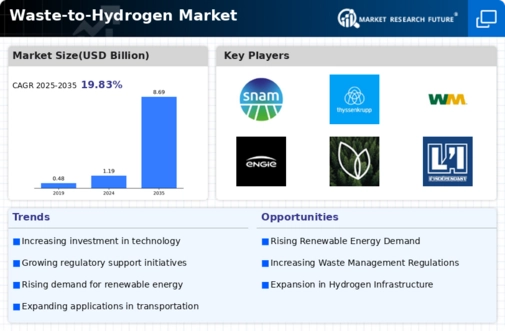Increasing Demand for Sustainable Energy Solutions
The Waste-to-Hydrogen Market is significantly influenced by the rising demand for sustainable energy solutions. As concerns over climate change and energy security intensify, there is a growing emphasis on transitioning to cleaner energy sources. Hydrogen, produced from waste, presents a compelling alternative to fossil fuels, offering a zero-emission energy carrier. Market data indicates that the demand for hydrogen is expected to reach 200 million tons annually by 2030, driven by sectors such as transportation and industrial applications. This increasing demand is likely to propel investments in waste-to-hydrogen technologies, as stakeholders seek to capitalize on the potential of waste as a resource. The alignment of waste management practices with energy production is expected to create new opportunities within the Waste-to-Hydrogen Market.
Investment Opportunities in Waste-to-Hydrogen Market
The Waste-to-Hydrogen Market is witnessing a surge in investment opportunities as stakeholders recognize the potential of waste as a resource for hydrogen production. Venture capital and private equity firms are increasingly directing funds towards innovative waste-to-hydrogen projects, driven by the promise of high returns and environmental benefits. Market analysis suggests that investments in this sector could exceed 10 billion dollars by 2030, as more companies seek to diversify their energy portfolios and align with sustainability goals. Additionally, public-private partnerships are emerging as a viable model for financing waste-to-hydrogen initiatives, enabling shared risk and resource allocation. This influx of capital is likely to accelerate the development and commercialization of waste-to-hydrogen technologies, further propelling the growth of the Waste-to-Hydrogen Market.
Technological Innovations in Waste-to-Hydrogen Market
The Waste-to-Hydrogen Market is experiencing a surge in technological innovations that enhance the efficiency of hydrogen production from waste materials. Advanced gasification and pyrolysis technologies are being developed, which convert organic waste into hydrogen with higher yields and lower emissions. For instance, recent advancements have led to the development of integrated systems that combine waste sorting, gasification, and hydrogen purification, streamlining the entire process. This not only reduces operational costs but also increases the overall viability of waste-to-hydrogen projects. As a result, the market is projected to grow significantly, with estimates suggesting a compound annual growth rate of over 15% in the coming years. These innovations are likely to attract investments and foster collaborations among stakeholders in the Waste-to-Hydrogen Market.
Regulatory Frameworks Supporting Waste-to-Hydrogen Market
The Waste-to-Hydrogen Market is bolstered by supportive regulatory frameworks that promote sustainable waste management and renewable energy production. Governments are increasingly implementing policies that incentivize the conversion of waste into hydrogen, recognizing its potential to reduce landfill waste and greenhouse gas emissions. For example, various countries have established feed-in tariffs and renewable energy credits for hydrogen produced from waste. These regulations not only provide financial support but also create a favorable environment for investment in waste-to-hydrogen technologies. As a result, the market is likely to witness a steady influx of projects aimed at harnessing waste for hydrogen production, contributing to a more sustainable energy landscape. The alignment of regulatory measures with environmental goals appears to be a driving force in the expansion of the Waste-to-Hydrogen Market.
Public Awareness and Acceptance of Waste-to-Hydrogen Technologies
The Waste-to-Hydrogen Market is benefiting from a growing public awareness and acceptance of waste-to-hydrogen technologies. As communities become more informed about the environmental impacts of waste and the benefits of hydrogen as a clean energy source, there is a shift in public perception. Educational campaigns and outreach initiatives are playing a crucial role in fostering acceptance of waste-to-hydrogen projects. This increased awareness is likely to lead to greater community support for local initiatives, facilitating project development and implementation. Furthermore, as more successful case studies emerge, public confidence in the viability of waste-to-hydrogen technologies is expected to grow. This trend may encourage local governments and private entities to invest in waste-to-hydrogen projects, thereby enhancing the overall growth of the Waste-to-Hydrogen Market.


















Leave a Comment